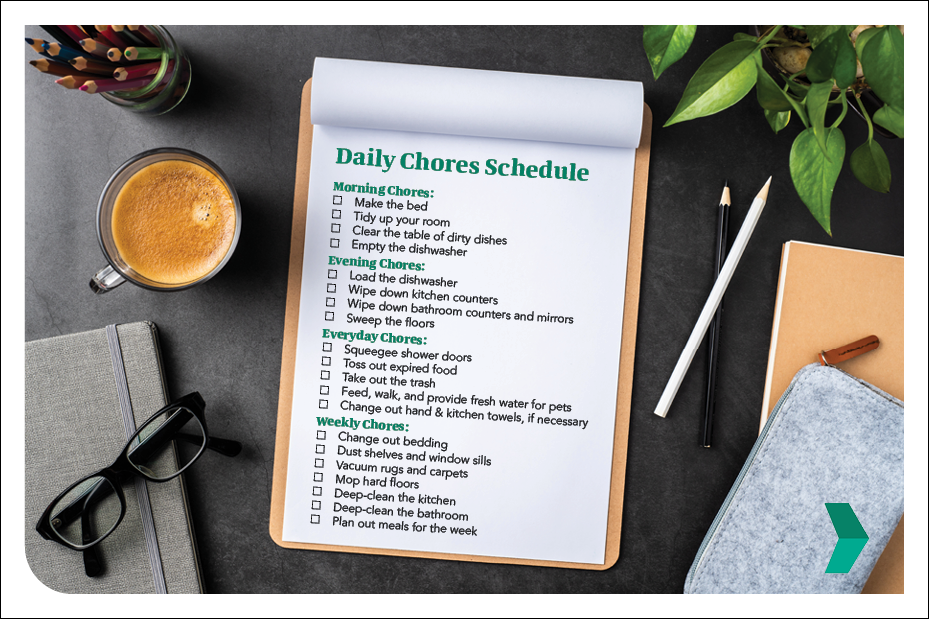Easy & Essential New Year’s Resolutions for Your Home
Jillyan Rogers, CMA, Mortgage AdvisorDecember 19, 2022 — 7 min read

It’s a brand new year, and you know what that means—everyone and their dog talks big, but how many people actually follow through with their new year’s resolutions? On average, only nine to twelve percent of people keep their new year’s resolutions, according to recent studies. These tasks are important for every homeowner to be aware of, so if you’re trying to get better at them, it’s best to plan things out ahead of time. Below, we share resources and tips to help you keep a realistic cleaning schedule, reduce energy consumption in your living space, and keep up on important winter home maintenance tasks.
Create a Realistic Cleaning Schedule
If you have a realistic cleaning schedule, you’re that much closer to keeping your home extra tidy all year long; plus, if you’re selling your home, a realistic cleaning schedule will help ensure your space is spic-and-span for potential showings!
However, remember those studies we mentioned earlier? When asked why they didn’t keep their resolutions, the majority of respondents said they set unrealistic goals and didn’t keep track of their progress. The same idea applies to keeping a clean house—it’s unrealistic to expect that you can keep your house perfectly spotless at all times. Don’t be hard on yourself when it comes to keeping a cleaning schedule and avoid feelings of failure by making sure your expectations are realistic from the beginning.
So, what’s a realistic cleaning schedule look like … realistically? Start with these three steps:
Figure Out Your Cleaning Habits
The secret to a clean house? It may seem silly, but after a long day, you don’t want to have to think about cleaning—you just want it done! Put in the work ahead of time to create cleaning habits. Start small, invite family members or housemates to help, and encourage yourself with small rewards. Ideally, these tasks will just take a few minutes but will make a big difference in your quality of life.
For example, for a typical household, daily cleaning habits may include:
- Making the bed
- Loading/unloading the dishwasher
- Folding laundry
- Feeding the dog/taking the dog for a walk
- Sweeping the floors
Organize Your Cleaning Habits in a Realistic Cleaning Schedule
This will help if you’re short on time but still want to keep an orderly home—because when you’re busy and stressed, a messy home is only going to make you anxious!
Organize your tasks into a cleaning schedule that makes sense for your daily life. Depending on what you have going on, you can organize this in whatever way makes the most sense to you. For the majority of people, it makes sense to divide tasks into morning chores, evening chores, everyday chores, and weekly chores. Depending on your home and household, your schedule may look something like this:

Get Family Members and/or Roommates Involved
Remember, you don’t have to do everything—if there’s someone else who lives in your home, invite them to help! In moderation, this is especially important if you have kids. It will teach them valuable skills and give them self-esteem as they feel they make vital contributions to the household.
RELATED: Genius Spring Cleaning Tips That Won’t Break the Bank
How to get others involved in helping with the cleaning schedule:
Make it fun: Kids are a lot more likely to participate if you make cleaning entertaining by playing music or creating a game around the cleaning process. For instance, you could have a competition to determine who cleaned the space best.
Set clear expectations: If you think your children and spouse will help out with the cleaning without any prompting, you may need to think again. It may be helpful to set a few simple ground rules, such as:
- Make your bed every morning
- Pick up your toys before playing with new ones
- Bring your dishes to the sink and rinse them after eating
- Take the trash out when you notice it’s full

Reduce Energy Consumption at Home
This one’s a win-win…win. By reducing your energy consumption at home, you’re saving money, increasing energy security, and reducing pollution emitted from non-renewable energy sources. There are a lot of ways to do this, but we’ll start with the most basic ways to reduce energy consumption at home.
First, examine your utility bill. On average, national electricity consumption sits at about 1000 kWh/month, according to energy officials. If you use more than this, even greater savings may be possible.
Then, take action. If you’d like to see that number decrease, here are a few easy ways to get started:
- If you’re going to need to replace appliances or electronics, look into purchasing energy-efficient products. Use an advanced power strip to reduce the energy that’s wasted when electronics are not in use.
- Get into the habit of turning the lights off when you leave a room. This may seem like a simple resolution, but it has the potential to make a big difference in your electric bill.
- Take shorter showers. No one sings quite like you, but the shorter the shower, the less hot water your water heater needs to heat, which means a lower electric or gas bill at the end of the month.
- Keep doors and windows closed to prevent hot or cold air from flowing into your home and forcing your system to work harder than it should.
- Did you know that most of the energy used by your washing and drying machines goes toward warming the water? To reduce energy in this area, avoid washing only half loads of dishes or laundry. Wait until the load is full before running it.
Stay on Top of Seasonal Home Maintenance
If you resolve to regularly perform simple home maintenance tasks, you’ll save a lot of money down the road, and could benefit from improved health and greater energy efficiency. Here are seven easy home seasonal home maintenance resolutions to get you started in the new year:
Check your furnace filter. In case you didn’t know, your furnace filter keeps dust, soot, and other debris from collecting inside your furnace; in turn, this reduces the number of airborne contaminants that enter your home.
If your filter is dirty, it forces the furnace to work harder, which increases operation costs. You should check or replace your furnace filter every three months or so, depending on your lifestyle and the type of furnace filter.

Clean and inspect your gutters and downspouts. It's important to keep your gutters and downspouts clean and clear of debris. Regularly check (at least at the beginning of each season) for loose or leaking gutters or gutters that aren’t draining properly; Your downspouts should drain away from your home’s foundation and be kept clear of debris.
RELATED: How Do I Keep Rainwater from Damaging My Home?
Clean your dryer duct and filter.
If possible, your lint screen, located in the door opening of the dryer, should be thoroughly after every load. If you have a newer machine, you may have an indicator light to remind you to clean the lint screen before each load.
REMEMBER: Don’t operate the dryer with the lint screen loose, damaged, blocked, or missing. This can cause overheating and damage the machine or your clothes.
Test your smoke detectors and carbon monoxide alarms. This one’s easy—if you look closely, you’ll see a little button on these devices. That’s a test button that you can push to ensure it is working properly. You may need to get up on a chair or use a broom handle to push the button. These should be tested about once a month.
The Best Way to Achieve New Year’s Resolutions for Your Home? Partner Up with Someone You Trust.
You have the best intentions, but you’re worried these new year’s resolutions for your home may not last—set yourself up for success by asking someone to hold you accountable, or reach out to your neighborhood Mortgage Advisor for more tips and advice. Cheers to a bright and happy new year!
Keywords:
Categories
Archives
Recent Posts
- No Down Payment for First-Time Homebuyers
- How Does A 30-Year Mortgage Work: A Simple Guide
- Your Comprehensive Homebuying Checklist: A Step-By-Step Guide
- Mortgage Pre-Approval: Everything You Need to Know
- What Are the Benefits of a USDA Loan for Homebuyers?
- How Many People Can Be On A Home Loan? Your 2024 Guide
You bring the dream. We'll bring the diagram.
There’s a financing solution for just about every situation.
I felt like I was treated like family, great communication and helping me with any questions I had.

You bring the dream. We'll bring the diagram.
There’s a financing solution for just about every situation.
Where does your sun shine? Find your local advisor.
Enter your city or state to see advisors near you.
